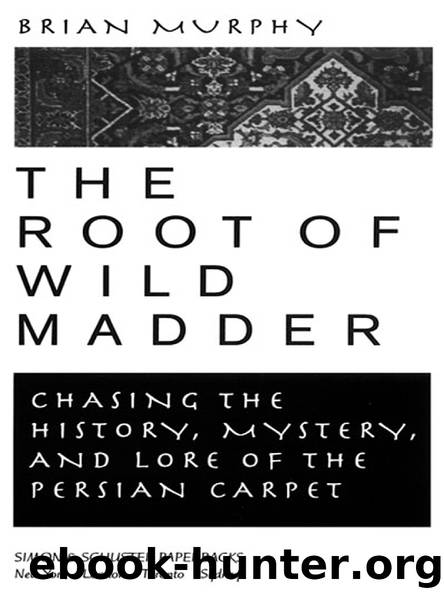THE ROOT OF WILD MADDER by BRIAN MURPHY

Author:BRIAN MURPHY
Language: eng
Format: epub
Publisher: SIMON & SCHUSTER PAPERBACKS
Published: 2005-07-15T00:00:00+00:00
The precise eureka moment of marketable chemical dyes is debatable. But it’s possible to start the story from a very humble point: a lump of charcoal.
Charcoal was the type of business that made simple men rich back in the fifteenth century: low overhead and a captive market. All it required was heating wood in an airtight oven. Out came what every metal smelter needed. Charcoal burns hotter and cleaner than logs and was the most valuable fuel of the day. But it led to a classic case of demand outstripping resources. Trees were coming down too fast in Europe. Wood was getting scarce and more costly.
Metalsmiths started to look around for alternatives to fire their furnaces. Coal was no good because its sulfur and other impurities weaken metals. But in the early 1600s, an enterprising tinkerer named Hugh Piatt had an idea: try heating coal with the same anaerobic charcoal-making method. The result was a porous and high-carbon substance dubbed coke. Some other interesting by-products were also kicked up. Among them was a smelly and chemically complex goo they called coal tar.
A German chemist, Friedlieb Runge, started to play around with it in the 1800s.
Runge had already hit the bull’s-eye once. He won considerable fame for isolating the first pure caffeine sample from Arabian mocha beans. He was in the market for another breakthrough to impress his friend and patron, the poet and science aficionado Johann Wolfgang von Goethe. Distilled coal tar yielded, among other interesting things, a colorless and oily compound called aniline.
This caught Runge’s attention.
Aniline was first isolated in 1826 by the destructive distillation of the blue-dye-producing plant indigo. Aniline is getting right down to the basic levels of organic chemistry. Once there, scientists knew they could start remixing compounds in exciting new directions, ways that eventually led to drugs, plastics, rubber, and other applications.
In the early 1830s, Runge joined the small fraternity of scientists who were exploring laboratory-produced dyes. By the time Runge came along, no one had yet succeeded in making a dye that was beautiful, commercially viable, and nonfugitive, meaning it didn’t easily run or fade.
On a hunch, Runge took aniline and mixed it with bleaching powder. Out came a brilliant blue. For the first time, dye makers had an alternative to the ancient menu of drawing blues from the indigo plant and other natural sources.
But it wasn’t until about 1856 that a truly popular synthetic dye arrived on the scene. Pungent coal tar again was the start.
The quest this time was for quinine, which was then the sole treatment for malaria and available only from the bark of a South American tree.
Malaria had plagued parts of Europe as far back as antiquity. But there was a special urgency now for a new, easy quinine source: the expanding British Empire. A lowly mosquito threatened to complicate Britannia’s reach through Asia and Africa. At least that is what Her Majesty’s envoys told the Royal College of Chemistry and its director, August Wilhelm Hofmann. What the queen wants, the queen gets.
Download
This site does not store any files on its server. We only index and link to content provided by other sites. Please contact the content providers to delete copyright contents if any and email us, we'll remove relevant links or contents immediately.
| Concrete | Extraction & Processing |
| Fracture Mechanics | Materials Science |
| Metallurgy | Polymers & Textiles |
| Strength of Materials | Testing |
Whiskies Galore by Ian Buxton(40508)
Introduction to Aircraft Design (Cambridge Aerospace Series) by John P. Fielding(32346)
Small Unmanned Fixed-wing Aircraft Design by Andrew J. Keane Andras Sobester James P. Scanlan & András Sóbester & James P. Scanlan(32148)
Craft Beer for the Homebrewer by Michael Agnew(17463)
Turbulence by E. J. Noyes(7057)
The Complete Stick Figure Physics Tutorials by Allen Sarah(6647)
Kaplan MCAT General Chemistry Review by Kaplan(6066)
The Thirst by Nesbo Jo(5793)
Bad Blood by John Carreyrou(5782)
Learning SQL by Alan Beaulieu(5424)
Weapons of Math Destruction by Cathy O'Neil(5046)
Man-made Catastrophes and Risk Information Concealment by Dmitry Chernov & Didier Sornette(4748)
iGen by Jean M. Twenge(4705)
Digital Minimalism by Cal Newport;(4567)
Life 3.0: Being Human in the Age of Artificial Intelligence by Tegmark Max(4520)
Audition by Ryu Murakami(4107)
1,001 ASVAB Practice Questions For Dummies by Powers Rod(4045)
Electronic Devices & Circuits by Jacob Millman & Christos C. Halkias(4041)
Pale Blue Dot by Carl Sagan(4017)
